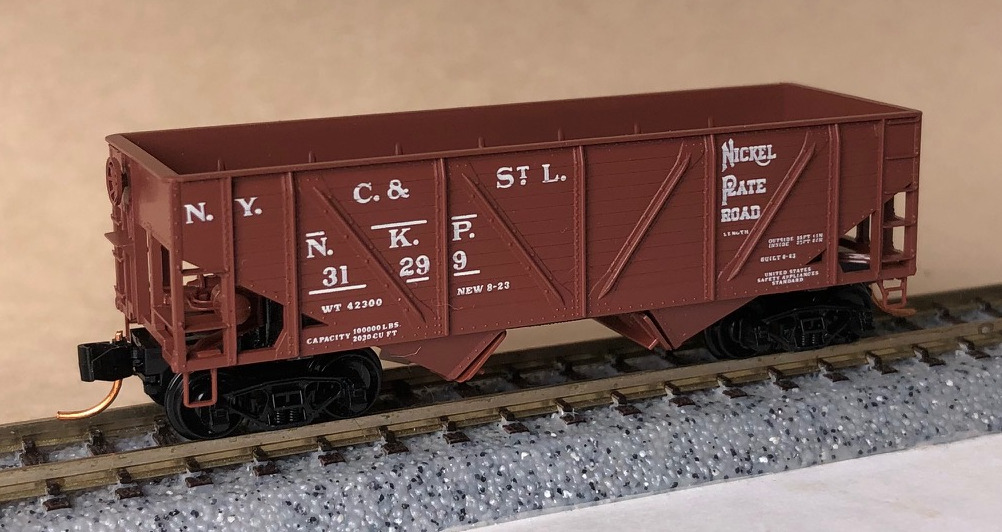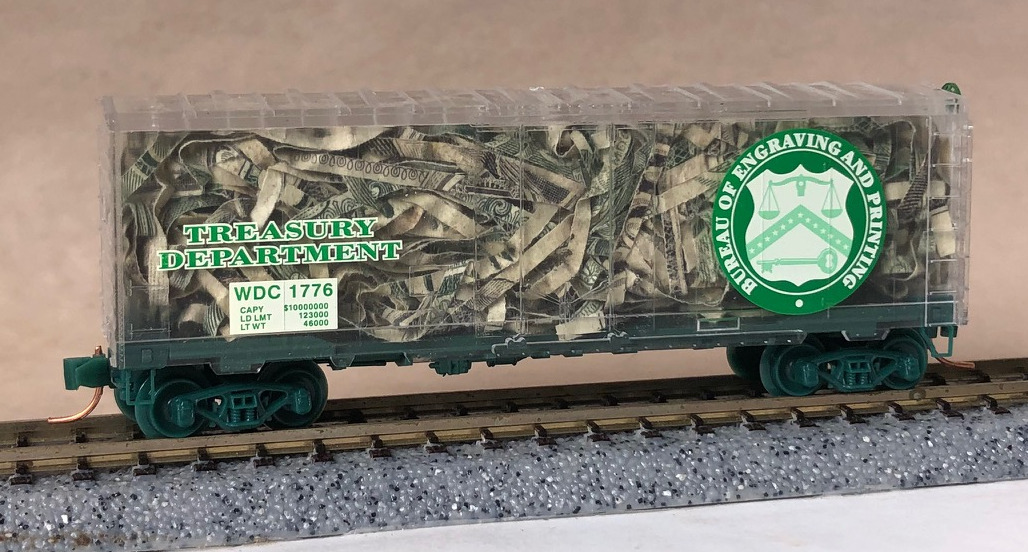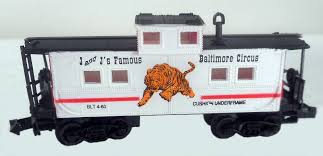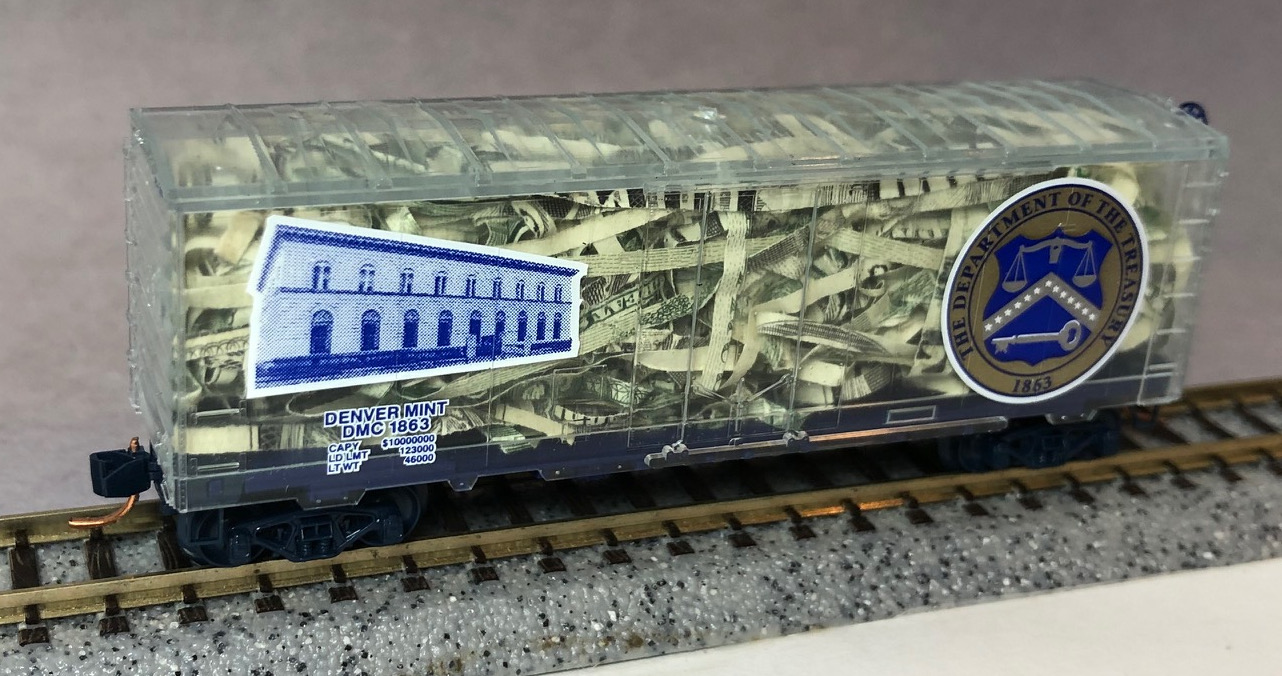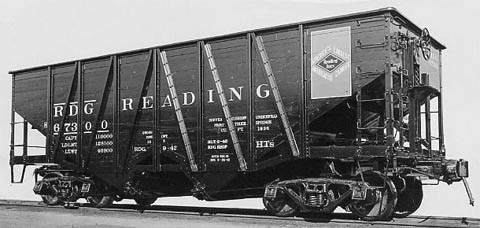Specific Item Information: 57051 is the Rapido Coupler version.
Prototype History: The story of these 2-Bay War Emergency Hoppers begins in 1942 when the War Production Board directed car builders to substitute wood for steel wherever possible in car superstructures. The familiar 2-Bay War Emergency Composite Hopper was a result of this directive. Those cars had wooden side sheets and end slope sheets (although the middle slope sheets remained steel.)
The wood siding was thicker than comparable steel sheeting and this reduced the capacity of the cars. While you could build ten composite cars with the steel from nine all-steel cars, it took more composite cars to move the same amount of coal. This combined with the more frequent repairs required by the composite cars soured the War Production Board on the design.
During 1944, the directive was set aside and cars that were on order were delivered with the familiar diagonal bracing but with all steel construction. After the war, as composite cars came due for serious maintenance, the wood side and slope sheets were replaced with steel. A large majority of the composite cars were rebuilt in this manner sometime during the 1950s.
From Bluford Shops
The wood siding was thicker than comparable steel sheeting and this reduced the capacity of the cars. While you could build ten composite cars with the steel from nine all-steel cars, it took more composite cars to move the same amount of coal. This combined with the more frequent repairs required by the composite cars soured the War Production Board on the design.
During 1944, the directive was set aside and cars that were on order were delivered with the familiar diagonal bracing but with all steel construction. After the war, as composite cars came due for serious maintenance, the wood side and slope sheets were replaced with steel. A large majority of the composite cars were rebuilt in this manner sometime during the 1950s.
From Bluford Shops
Road Name History: 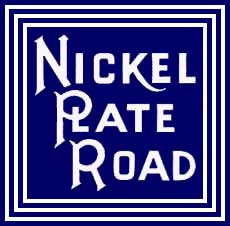 The New York, Chicago and St. Louis Railroad (reporting mark NKP), abbreviated NYC&St.L, was a railroad that operated in the mid-central United States. Commonly referred to as the Nickel Plate Road, the railroad served a large area, including trackage in the states of New York, Pennsylvania, Ohio, Indiana, Illinois and Missouri. Its primary connections included Buffalo, Chicago, Cincinnati, Cleveland, Indianapolis, St. Louis, and Toledo.
The New York, Chicago and St. Louis Railroad (reporting mark NKP), abbreviated NYC&St.L, was a railroad that operated in the mid-central United States. Commonly referred to as the Nickel Plate Road, the railroad served a large area, including trackage in the states of New York, Pennsylvania, Ohio, Indiana, Illinois and Missouri. Its primary connections included Buffalo, Chicago, Cincinnati, Cleveland, Indianapolis, St. Louis, and Toledo.
The Nickel Plate Railroad was constructed in 1881 along the South Shore of the Great Lakes connecting Buffalo and Chicago to compete with the Lake Shore and Michigan Southern Railway. In 1964 the Nickel Plate Road and several other mid-western carriers were merged into the larger Norfolk and Western Railway (N&W). The goal of the N&W expansion was to form a more competitive and successful system serving 14 states and the Canadian province of Ontario on more than 7,000 miles (11,000 km) of railroad. The profitable N&W was itself combined with the Southern Railway, another profitable carrier, to form Norfolk Southern Corporation (NS) in 1982.
At the end of 1960 NKP operated 2,170 miles (3,490 km) of road on 4,009 miles (6,452 km) of track, not including the 25 miles (40 km) of Lorain & West Virginia. That year it reported 9758 million net ton-miles of revenue freight and 41 million passenger-miles.
The Nickel Plate Historical and Technical Society works to preserve the memory of the Nickel Plate Road.
From WIkipedia

The Nickel Plate Railroad was constructed in 1881 along the South Shore of the Great Lakes connecting Buffalo and Chicago to compete with the Lake Shore and Michigan Southern Railway. In 1964 the Nickel Plate Road and several other mid-western carriers were merged into the larger Norfolk and Western Railway (N&W). The goal of the N&W expansion was to form a more competitive and successful system serving 14 states and the Canadian province of Ontario on more than 7,000 miles (11,000 km) of railroad. The profitable N&W was itself combined with the Southern Railway, another profitable carrier, to form Norfolk Southern Corporation (NS) in 1982.
At the end of 1960 NKP operated 2,170 miles (3,490 km) of road on 4,009 miles (6,452 km) of track, not including the 25 miles (40 km) of Lorain & West Virginia. That year it reported 9758 million net ton-miles of revenue freight and 41 million passenger-miles.
The Nickel Plate Historical and Technical Society works to preserve the memory of the Nickel Plate Road.
From WIkipedia
Brand/Importer Information: Micro-Trains is the brand name used by both Kadee Quality Products and Micro-Trains Line. For a history of the relationship between the brand and the two companies, please consult our Micro-Trains Collector's Guide.
Manufacturer Information:  Kadee Quality Products originally got involved in N-Scale by producing a scaled-down version of their successful HO Magne-Matic knuckle coupler system. This coupler was superior to the ubiquitous 'Rapido' style coupler due to two primary factors: superior realistic appearance and the ability to automatically uncouple when stopped over a magnet embedded in a section of track. The success of these couplers in N-Scale quickly translated to the production of trucks, wheels and in 1972 a release of ready-to-run box cars.
Kadee Quality Products originally got involved in N-Scale by producing a scaled-down version of their successful HO Magne-Matic knuckle coupler system. This coupler was superior to the ubiquitous 'Rapido' style coupler due to two primary factors: superior realistic appearance and the ability to automatically uncouple when stopped over a magnet embedded in a section of track. The success of these couplers in N-Scale quickly translated to the production of trucks, wheels and in 1972 a release of ready-to-run box cars.
In October 1990 Kadee separated in two companies, with the newly created Micro-Trains® Line Co. continuing the Z, Nn3, and N Scale product ranges, with Kadee retaining the HO range.

In October 1990 Kadee separated in two companies, with the newly created Micro-Trains® Line Co. continuing the Z, Nn3, and N Scale product ranges, with Kadee retaining the HO range.
Item created by: Lethe on 2015-05-31 17:46:30. Last edited by gdm on 2020-11-09 13:23:07
If you see errors or missing data in this entry, please feel free to log in and edit it. Anyone with a Gmail account can log in instantly.
If you see errors or missing data in this entry, please feel free to log in and edit it. Anyone with a Gmail account can log in instantly.


